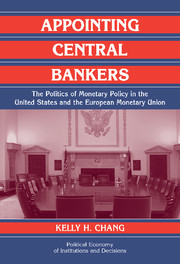 Appointing Central Bankers
Appointing Central Bankers Book contents
- Frontmatter
- Contents
- List of Figures
- List of Tables
- Acknowledgments
- 1 Introduction
- 2 A Formal Model of the Appointment Process
- 3 Estimating Monetary Policy Preferences
- 4 Empirically Testing the Model's Predictions
- 5 Appointments to the European Central Bank
- 6 The Origins of the Federal Reserve Appointment Process
- 7 Conclusions
- Bibliography
- Index
- Titles in the series
4 - Empirically Testing the Model's Predictions
Published online by Cambridge University Press: 05 September 2009
- Frontmatter
- Contents
- List of Figures
- List of Tables
- Acknowledgments
- 1 Introduction
- 2 A Formal Model of the Appointment Process
- 3 Estimating Monetary Policy Preferences
- 4 Empirically Testing the Model's Predictions
- 5 Appointments to the European Central Bank
- 6 The Origins of the Federal Reserve Appointment Process
- 7 Conclusions
- Bibliography
- Index
- Titles in the series
Summary
With the ideal point estimates from Chapter 3, this chapter tests the model's predictions from Chapter 2. For each Fed appointment opportunity, I use the ideal point estimates to order the appointing president and the Senate median among the Fed members who remain after the retiree leaves. This ordering produces a point prediction for the Fed median, which we can compare to the actual Fed median in the data.
The model is used to test two sets of hypotheses for the FOMC and the BOG. The first set of hypotheses answers the question of whether political influence on monetary policy occurs through Fed appointments. The second set concerns the question of influence by whom: the president alone or both the president and Senate. The chapter first considers these hypotheses for the FOMC and then for the BOG.
The results for both the FOMC and the BOG show that political influence occurs. On the FOMC, influence is by both the president and Senate, while on the BOG, it is unclear who influences. But because the FOMC is the more important monetary policy-making body, the results show generally that appointments are an important avenue of political influence on monetary policy by both the president and Senate rather than the president alone.
The chapter proceeds by describing the appointments data. I then restate the model's predictions and enumerate the exact procedures by which I test the predictions. Finally, I present the results in turn for the FOMC and for the BOG.
- Type
- Chapter
- Information
- Appointing Central BankersThe Politics of Monetary Policy in the United States and the European Monetary Union, pp. 59 - 90Publisher: Cambridge University PressPrint publication year: 2003
